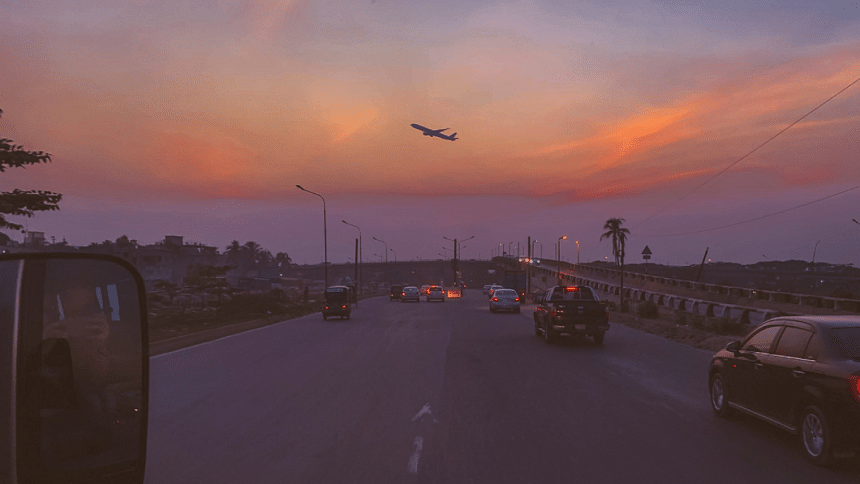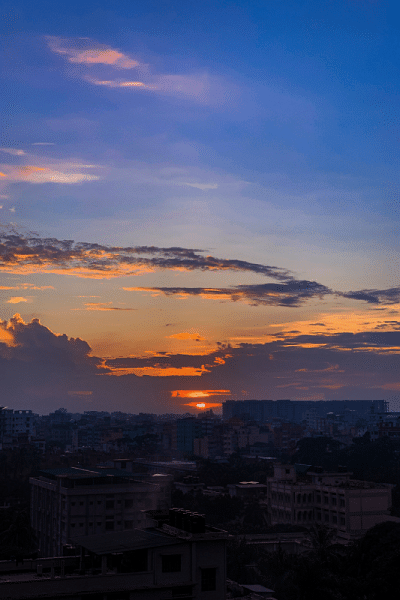The Science Behind These Beautiful Skies

A melody of crimson hues and crepuscular rays – the perfect Instagram shot. Lately, the sky has been enchantingly aesthetic. Although I have my doubts, is it just the sky or is it me who's losing her mind? With my social media feeds flooded with amateur sky photography, it's indeed worth pondering over – why is the sky so beautiful these days?
Commencing our quest, we first have to answer the question: Why is the sky blue? First things first, light travels in waves. The sunlight is white since it is made up of all seven colours of the colour spectrum – violet, indigo, blue, green, yellow, orange and red – VIBGYOR or ROYGBIV (remember kindergarten?). Each colour has a different wavelength, with violet having the shortest and red the longest. When sunlight reaches the Earth's atmosphere, the air particles interact with it, scattering the wavelengths in different directions.
Think of the Earth's atmosphere as a prism separating the sunlight into its seven colours. However, they all are not scattered the same. The shorter the wavelength, the faster the scattering upon entering the atmosphere. The more scattered a wavelength is, the better we see the colour. Wait a second! Was our sky supposed to be violet because it has the shortest wavelength?

Even though blue has a longer wavelength, the human eye is more sensitive to blue than it is to violet or indigo (thanks to the blue receptors in our retinas). Additionally, the Sun emits blue more strongly than it does either of these colours. Since the Earth's atmosphere is mostly composed of oxygen and nitrogen whose molecules are similar in size to that of blue wavelength, blue is yet the best deflected.
So, what about the times when the sky isn't blue, like during twilight hours? The sky changes its colours primarily due to the differing angles of the Sun. For instance, during sunrise and sunset, the Sun is much lower in the horizon. Consequently, the rays have to travel a greater distance through the atmosphere. Since the shorter wavelengths scatter faster, they are filtered way before the sunlight reaches our visibility. This leaves the longer wavelengths of red and orange to dominate the sky.
So far, we have discussed the usual nature of the sky. Now, what's making the recent skies so overwhelmingly breathtaking? Firstly, decreased pollution levels as a consequence of the recurrent lockdowns is a key player. Cleaner atmosphere means brighter skies. Pollutants like mineral dust, aerosol and sulphate particles absorb the wavelengths, decreasing their scattering and subsequently dimming the sky. In some cases, high density of pollutants literally block the light from entering our eyes.
Secondly, it's the monsoon season intensifying the sky palette. A more humid weather means more moisture is trapped in the atmosphere. As light travels, these water particles collide causing a greater degree of scattering.
All that leaves one last mystery – those occasional purple tints. When the atmosphere is cleaned up and bigger particles washed away after a rainfall, the remaining small particulates can successfully scatter the violet wavelengths creating spellbinding purple-tinged skylines.
It is so overwhelming to realise that the sky which evokes an artist's brush is itself a canvas so intricately designed. Amidst the lockdown blues and monsoon hues, the sky drapes itself in the colours of a different story every day. Red, blue, green . . . Oh, wait. Why is there hardly any green in our tropical skies? Well, that can be a conversation for another day.
Riyana is an introvert self-debating on whether she is an INFJ or INFP. Send her memes on introversion and MBTI personality tests on Instagram at @_raya_riyana_

 For all latest news, follow The Daily Star's Google News channel.
For all latest news, follow The Daily Star's Google News channel. 








Comments